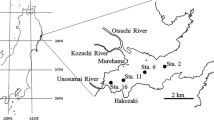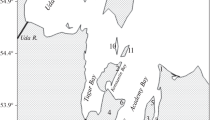Abstract
Ofunato Bay was a semi-closed area because of the breakwater effect at the entrance; however, the breakwater was destroyed by a massive tsunami generated by the 2011 off the Pacific coast of Tohoku Earthquake. Consequently, the physical environment of Ofunato Bay has been changed significantly, i.e., the modification of the stratified structure of seawater inside the bay and the intermittent intrusion of seawater outside the bay. These alterations of physical environment are considered to have an influence on the chemical and biological environment in Ofunato Bay. To elucidate the influence of the tsunami on the aquatic environment, we measured dissolved nutrients, chlorophyll a and dissolved oxygen concentrations, and heterotrophic bacteria abundance inside and outside of Ofunato Bay from 2012 to 2014, and compared these data with those obtained before the earthquake. As compared with before the earthquake, significant changes after the earthquake were (1) decrease of ammonium and phosphate concentrations, (2) increase of chlorophyll a concentration, (3) increase of dissolved oxygen concentration in the bottom, and (4) decrease of heterotrophic bacteria abundance. The collapse of the breakwater and consequential enhanced water exchange were considered to have brought the decrease of nutrient concentration inside the bay. Furthermore, washout of shellfish mariculture rafts by the tsunami decreased the shellfish biodeposits along with the elution of nutrients by heterotrophic bacteria. Decrease of cultivated shellfish further caused a decline in feeding pressure on phytoplankton and, subsequently, increased the phytoplankton biomass that contributed to the decrease of nutrients inside the bay.










Similar content being viewed by others
References
Fukuda H, Katayama R, Yang Y, Takasu H, Nishibe Y, Tsuda A, Nagata T (2015) Nutrient status of Otsuchi Bay (northeastern Japan) following the 2011 off the Pacific coast fo Tohoku Earthquake. J Oceanogr. doi:10.1007/s10872-015-0296-2
Furudoi K, Sakai S, Murakami K, Nakamura Y, Abe I, Okada T, Shibaki H, Takao T (2014) Analysis of influence factors to the water environment of Ofunato Bay based on the observed data. J Japan Soc Civil Engineers, Ser B2 70:426–430. doi: 10.2208/kaigan.70.I_426 (in Japanese with English abstract)
Hayakawa Y (1990) Mean seasonal changes of dissolved inorganic nutrients in the Ofunato estuary. Nippon Suisan Gakkaishi 56:1717–1729
Hayakawa Y, Kobayashi M, Izawa M (2001) Sedimentation flux from mariculture of oyster (Crassostrea gigas) in Ofunato estuary, Japan. ICES J Mar Sci 58:435–444
Hibino T, Tsuruya H, Itabashi N (2004) Seasonal variation characteristics of water structure and quantitative analysis of seawater exchange in Ofunato Bay. J Japan Soc Civil Engineers, Ser 761:69–80. doi: 10.2208/jscej.2004.761_69 (in Japanese with English abstract)
Holm-Hansen O, Lorenzen C, Holmes R, Strickland JDH (1965) Fluorometric determination of chlorophyll. J du Cons 30:3–15
Iwate Prefectural Land Development Section (2015) Overview of prefectural land development administration, 2015 version. Iwate prefecture Home page. Download from http://www.pref.iwate.jp/dbps_data/_material_/_files/000/000/015/349/h27kendogyousei.pdf (in Japanese)
Kataoka S (1998) About the current status and reproducibility of flow regime and water quality, and the role of aquaculture oyster. J Ocean Eng 45:481–485 (in Japanese)
Kemuriyama A (2011) The damage done to fisheries in Iwate Prefecture by the Great East Japan Earthquake. Nippon Suisan Gakkaishi 77:712–714. doi:10.2331/suisan.77.712 (in Japanese)
Mimura N, Yasuhara K, Kawagoe S, Yokoi H, Kazama S (2011) Damage from the Great East Japan Earthquake and Tsunami—a quick report. Mitig Adapt Strateg Glob Chang 16:803–818. doi:10.1007/s11027-011-9297-7
Miyazawa K, Hayakawa Y (1994) A large-scale structure and the environmental capacity for aquaculture—effects of and artificial structure (breakwater at the entrance of the Ofunato estuary) on aquaculture and water qualities in the estuary. Bull Coast Oceanogr 32:29–38 (in Japanese with English abstract)
Murakami A, Sakai S, Murakami K, Nakamura Y, Okada T, Takao T, Shibaki H (2013) Change in water and sediment quality in Ohfunato Bay induced by the 2011 Great East Japan Tsunami. J Japan Soc Civil Engineers, Ser B2 69:496–500. doi:10.2208/kaigan.69.I_496 (in Japanese with English abstract)
Ofunato City Agriculture and Fisheries Division (2004) Fisheries promotion plan in Ofunato City. Ofunato City Home page. Download from http://www.city.ofunato.iwate.jp/www/contents/1342083442949/files/suisan_keikaku.pdf (in Japanese)
Ofunato City Health and Environment Division (1986) The white book on environmental pollution of Ofunato City, 1986 version. p 84 (in Japanese)
Okawa M, Higashiyama K (2013) An examination of water passing hole in the underwater bank of opening part of the breakwater at the entrance of the Ofunato Bay. Rep Coast Dev Inst Tech 13:5–8 (in Japanese)
Terasawa T, Nakata K, Taguchi K (1995) Numerical modeling on the Ofunato Bay ecosystem including the oyster farming. In: Proceedings of 4th International Conference on Estuarine and costal modeling, ASCE, pp 530–541
Yamamoto T, Date E, Oda S (2010) Characteristics of sediment in Etajima Bay and influences of oyster cultivation on sediment. Bull Hiroshima Pref Tech Res Inst Public Health Environ Center 18:7–13 (in Japanese with English abstract)
Yamamoto M, Kato T, Tabetata S, Kitazawa D, Fujino M, Shozugawa K, Matsuo M, Tanaka K, Michida Y (2015) Changes in the coastal environment in Kamaishhi Bay after the Great East Japan Earthquake. Nippon Suisan Gakkaishi 81:243–255. doi:10.2331/suisan.81.243 (in Japanese with English abstract)
Acknowledgments
We are grateful to Y. Azuma and Ofunato Fisheries Cooperatives for their help in field sampling. This study was supported by the research program “Tohoku Ecosystem-Associated Marine Science” from the Ministry of Education, Culture, Sports, Science and Technology in Japan.
Author information
Authors and Affiliations
Corresponding author
Rights and permissions
About this article
Cite this article
Yamada, Y., Kaga, S., Kaga, Y. et al. Changes of seawater quality in Ofunto Bay, Iwate, after the 2011 off the Pacific coast of Tohoku Earthquake. J Oceanogr 73, 11–24 (2017). https://doi.org/10.1007/s10872-015-0336-y
Received:
Revised:
Accepted:
Published:
Issue Date:
DOI: https://doi.org/10.1007/s10872-015-0336-y




